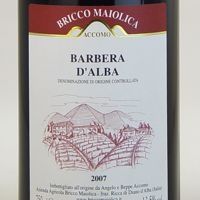Accomo, Bricco Maiolica 2007 Barbera d'Alba

From €9, CHF16.90, £12.95, US$15.99, ¥ 2,310
Beppe Accomo's Bricco Maiolica 2007 Barbera d'Alba is a double-edged sword: fresh and lively enough to quench your thirst, lift your spirit and revive your tastebuds and yet so deliciously fragrant that you want to delay sipping it so you can continue to savour the aromas of strawberries and blossom without being distracted by the the flavours in your mouth – savoury yet with plenty of juicy fruit and a slight tension courtesy of very fine, lightish tannins.
Wine never ceases to amaze me. You start with a grape that has a limited range of flavours and not much aroma and end up with a wine like this. And it doesn't cost a fortune.
Barbera is a widely planted and useful variety but yields have to be held in check to produce a wine like this, and older, well-tended vines such as those at Bricco Maiolica (those for this wine were planted in 1975) are ideal. In the 1980s Barbera was even more widespread than it is today but it is still far and away the most widely planted variety in Piemonte in north-west Italy, grown on more than a third of the region's vineyards, according to the most recent (2001) official figures. It's also cultivated in Lombardia, Emilia-Romagna and here and there in the south, making it the third most planted dark-skinned variety in Italy after Sangiovese and Montepulciano.
In Piemonte the grape gives its name to one DOCG (Barbera d'Asti) and two DOCs (Barbera d'Alba and Barbera di Montferrato). The Accomo's Azienda Agricola Bricco Maiolica, which has been in the family since 1928, is on a steep hillside in Diano d'Alba in the province of Alba, which, together with the province of Asti, is the variety's heartland. Of the almost 16,500 ha (getting close to 41,000 acres) in Piemonte, Beppe Accomo and his family have just 5 ha of Barbera, planted on south-west facing slopes at 350-370 m above sea level. They also produce a denser, oaked Barbera called Vigia, made from older vines planted in the 1930s.
 Winemaking is very simple: the wine is fermented and then aged for 10 months in stainless-steel tanks but still has a light spicy flavour as if it had brushed cheeks with some older oak barrels. The acidity is refreshing but not tart and I'd anticipate that it's very easy to match with a wide range of uncomplicated dishes. I tasted it without food but the producer's website says: 'matches well with easy food (pizza, salami, barbecued/grilled meat) and soft, unripe cheeses'. Ideal, they suggest, with the Piemontese 'hot sauce' bagna càuda.
Winemaking is very simple: the wine is fermented and then aged for 10 months in stainless-steel tanks but still has a light spicy flavour as if it had brushed cheeks with some older oak barrels. The acidity is refreshing but not tart and I'd anticipate that it's very easy to match with a wide range of uncomplicated dishes. I tasted it without food but the producer's website says: 'matches well with easy food (pizza, salami, barbecued/grilled meat) and soft, unripe cheeses'. Ideal, they suggest, with the Piemontese 'hot sauce' bagna càuda.
Beppe Accomo is pictured on the back row with his two children, his wife Loredana front right and Beppe's parents Emiliana and Angelo either side of her.
The wine is available in the UK from Lea & Sandeman. In the US, Accomo's wines are distributed by West Park Imports in Philadelphia and Delaware and by Zancanella Importing in Portland, Oregon. Itashoku Co in Kyoto is the Japanese distributor.
Become a member to view this article and thousands more!
- 15,423 featured articles
- 274,424 wine reviews
- Maps from The World Atlas of Wine, 8th edition (RRP £50)
- The Oxford Companion to Wine, 5th edition (RRP £50)
- Members’ forum
- 15,423 featured articles
- 274,424 wine reviews
- Maps from The World Atlas of Wine, 8th edition (RRP £50)
- The Oxford Companion to Wine, 5th edition (RRP £50)
- Members’ forum
- Commercial use of our Tasting Notes
